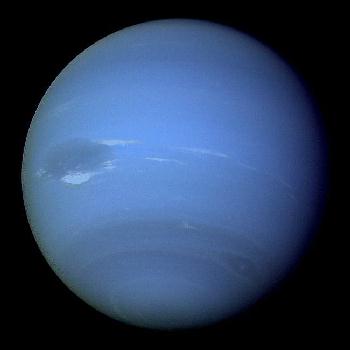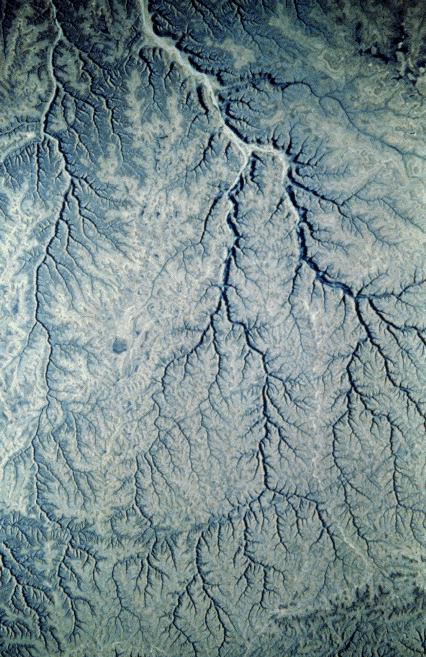

Summary
Students explore the solar system using a series of images taken by many different spacecraft.
Background and Theory
One of the most important areas of astronomy is the field of comparative planetology. By studying planets and other large bodies in the solar system, we learn about the history and possible future of our own. Some large bodies, such as Mars, Mercury and the Moon, have preserved a record of the history of the solar system, in their craters and in the evidence for lava flows and other surface alterations. On the other hand, Venus gives a frightening glimpse into a possible future of the Earth, should the "greenhouse effect" become significant here.
Even the giant planets, different though they seem, offer insight into the formation of the solar system, its stability, and its history, and therefore are important to a complete understanding of the Earth's history. In particular, the moons of the outer planets are in some cases comparable to inner solar system objects.
Procedure
Print out the worksheet.
Part 1: Craters Around the Solar System
The early Solar System had lots of debris. Ancient impact craters are therefore common in the Solar System. In this section, you will look at photos of the terrestrial planets taken by various spacecraft.
Planetologists use images like these to get information about a planet's environment. Look at the pictures shown and consider the numbers of craters, their shape and size, and more importantly the number of craters of each size. Use this information to answer the question below.
| Meteor Crater in Arizona | Mars: Optical Image 1 |
 |
 |
Mercury: Optical Image
From Mariner 10 | Lunar Craters |
 |
 |
Venus: Crater Cunitz | Footprint on the Moon |
 |
 |
- On Venus, craters of less than 2km across are almost non-existent, while
on Mercury, Mars and the Moon, large and very small craters can be seen.
Why is this the case?
- When we think about cratering, we usually think of big rocks falling
onto a planet, but even tiny pebbles can make craters. Near the footprint
in the above picture, you can see many small "pock-marks." These marks are
the craters made by microscopic particles that hit the surface moving at
speeds of several kilometers per second. Marks like these can not be found
on the Earth's surface. Why not?
- Craters accumulate over time. This means that the number of craters you see gives a rough idea of the age of the surface. Using this method, sort the surfaces of Venus, Earth, Mercury, Mars and the Moon by age. How can you reconcile these vastly different ages with the idea that all the planets formed at the same time?
Part 2: Volcanism Around the Solar System
Volcanism can be very important in shaping the surface features of a planet.
Venus has a large number of unique volcanic features. On Earth, when
volcanos erupt, the molten lava within them can travel great distances
before it cools. However, on Venus, molten lava does not travel very far
before it cools. Compare these examples of shield volcanoes on Venus and
on Earth.
| Shield volcanoes on Venus - The Pancake Domes | Shield volcanoes on Earth - The Galapagos Islands |
 |
 |
- Give two pieces of evidence that Venusian lava does not flow far before cooling.
- What might cause the difference between the two planets?
Part 3: Channels of Mars
Life as we know it requires water. Because of this, observations implying
the possiblity of water on Mars are of tremendous interest for scientists
and the general public. Compare these pictures of Earth and Mars.
| Mars Channel Features | Imprint of flowing water
in the desert of the Republic of South Yemen |
 |
 |
- What are the similarities between these surface features? What does this suggest about the possiblity of water on Mars?
- Scientists who disagree with the hypothesis that the Martian channels were caused by flowing water often point out that it is not clear where the water comes from, or where it goes. In the Yemen image, the water flows from the top of the image in a number of tributaries which combine to form the river which flows off the bottom of the image. This implies that "down" in the image is downhill on Earth. Examine the Mars Channels. Which direction is downhill? How do you know?
- Sketch the apparent flow of water through the Martian Channels. Identify the "sources" (places where the water comes from), and the "sinks" (places where the water goes). Are you convinced that these channels were created by flowing water such as is found on Earth? Can you think of another explanation for geological formations like these?
Part 4: Giant Planets
Look at these images of the outer Gas Giant Planets.
| Jupiter | Saturn with Storm |
 |
 |
| Uranus | Great Dark Spot on Neptune |
 |
 |
- The different compositions of the outer planets give them their
different colors. Jupiter and Saturn appear yellowish and reddish because
of the polysulfides and phosphorus in their atmospheres. Uranus and Neptune
have more methane and ammonia in their atmospheres and so they appear bluish.
Notice that while Jupiter, Saturn and Neptune have much structure in their
atmospheres, Uranus looks very smooth with no obvious features. What
does this tell us about the interior of Uranus compared to the other giant
planets?
- The bands and stripes on Jupiter, Saturn and Neptune are common to all
planets with atmospheres. On the Earth, these bands are trade winds (westward surface winds), and jet streams (eastward high-altitude winds). On the Earth, and Venus, the energy that drives the winds comes from the Sun, which heats the ground and the lower atmosphere, starting the process of convection. However, Jupiter, Saturn and Uranus have no "ground", and are much too far from the Sun for their winds to be "solar-powered". Where does the energy to drive these winds come from?
© 2003 Weber State University
Revised: April 24, 2003




















